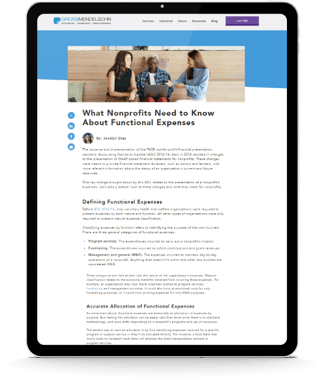The Paycheck Protection Program (PPP) is in the forgiveness stage for most businesses. Here’s an overview on how to navigate the PPP loan forgiveness process.
Which PPP Loan Forgiveness Form to Use
To apply for PPP forgiveness, the Small Business Administration (SBA) has issued three forms (and a lender alternative to each form may also be used):
Form 3508
This is what I call the “long form.” Compared to the other form mentioned below, it requires a greater amount of detail to be entered in order to qualify for loan forgiveness.
Form 3508EZ
This form is what I call the “simple form.” It requires less detail than Form 3508, but its use is limited to businesses that meet one of the following criteria:
-
A sole proprietor who is self-employed or individual contractors with no employees
-
An employer that didn’t reduce salaries of employees by more than 25% and didn’t reduce employees’ hours
-
An employer that didn’t reduce salary by more than 25%, but was unable to operate due to COVID requirements
If you don’t easily fit in one of those three categories, you need to use the more complex Form 3508.
Form 3508S
This form is available for use by entities that had loans of $150,000 or less. SBA Form 3508S requires fewer calculations and less documentation for eligible borrowers. SBA Form 3508S does not require borrowers to show the calculations used to determine their loan forgiveness amount. However, the SBA may request information and documents to review those calculations as part of its loan review or audit processes.
What’s Included In Salary Costs for Forgiveness?
Salary
Salary is the gross amount of your employee’s salary and includes any state and local taxes assessed on it to the employer. It’s not the employee’s state and local withholding. Instead, for example, it would be unemployment taxes.
Retirement Plans
The cost associated with retirement plans comes from any contributions you make to the retirement plan during the loan forgiveness period. Note that you can't accelerate contributions in order to maximize the retirement plan deduction related to salary.
Health Insurance
Any health insurance premiums (including dental, vision, group life and disability) that you pay qualify for loan forgiveness. However, do not include in your cost calculation any withholdings you make for your employees. It’s only the net amount that you pay that qualifies. For example, if you write a check for $10,000 a month to cover your employees’ health insurance for the entire company, but withhold $2,000 a month from your employees’ salary to cover the employees’ portion, then only $8,000 qualifies for loan forgiveness.
Calculating Salary Based On Your Ownership Type
The ownership type for your business also plays a role in your salary calculation.
C Corporation
As an owner of a C corp, you should include salary and retirement and health insurance expenses in your calculation.
S Corporation
As an owner of an S corp, you should include salary and retirement plan expenses. Health insurance premiums aren’t included due to those costs being included in your salary.
Partnership
For partnerships, include only your self-employed income in your calculation.
LLC
If you own an LLC, your salary calculation is based on whether your LLC is taxed as a C corp, S corp or partnership.
Other Expenses Included in Loan Forgiveness
There are other types of expenses, in addition to salaries, that qualify for PPP loan forgiveness.
Rent
Your business’s rent as well as automotive or equipment leases that were in effect prior to February 15, 2020 are eligible for forgiveness. Rents to related parties are subject to more stringent rules to qualify for forgiveness.
Interest
Another allowable expense is interest on mortgages and other secured loans. Those loans, however, must have been in place prior to February 15, 2020.
Utilities
Utility expenses include telephone (both cell phone and landlines), internet, gas, electric and water. Auto expenses do not fall into the utility category. The guidance was clarified to explain transportation utility fees are the only transportation utility that qualifies. These are assessments by state and local governments in certain parts of the country so there was some early confusion on this issue.
Calculating the Forgivable Loan Amount
It’s important to understand that even if you spent the loan money in exact accordance with the rules (payroll and related expenses, rent, utilities, etc.) it’s not a given that 100% of the loan will be forgiven. You must determine what percentage of the loan is forgivable.
There are two calculation methods used for determining whether your loan is forgivable, and it’s based on the monthly average number of full-time employees (FTEs).
The Complex Method
-
Add up all of your employees
-
Prorate their hours for up to 40 hours a week
-
Average the hours over the loan period to determine the number of full-time employees
-
Do the same calculation for two comparable time periods prior to the pandemic
-
Divide the number of full-time employees in the loan period by the lower of the two full-time employee counts in the comparable time periods for a percentage of the loan that is forgivable
The Simplified Method
-
Determine how many employees work 40 hours in a week and count them as full-time employees
-
Determine how many employees work less than 40 hours a week and count them as “half” employees
-
Add these numbers together for your total full-time employees
-
Do the same calculation for two comparable time periods prior to the pandemic
-
Divide the number of full-time employees in the loan period by the lower of the two full-time employee counts in the comparable time periods for a percentage of the loan that is forgivable
I recommend making the calculation both ways. By doing so, you can figure out which method provides the highest percentage of forgiveness on allowable costs for your PPP loan.
You should ask your payroll preparer or payroll provider for this information. If you use a payroll provider such as Paychex or ADP, they should be able to produce these reports for you. If you handle payroll internally, then you’re going to have to make this calculation on your own. The accuracy of these calculations is important as the documentation of these calculations is necessary for loan forgiveness.
Submitting Your PPP Loan Forgiveness Application
You can submit your loan forgiveness application through your bank. The SBA is also allowing borrowers with less than $150,000 in PPP loans to apply for forgiveness directly through the SBA.
Important Legislative Changes
Initially, businesses were required to use 75% of their PPP loan on payroll costs and the remaining 25% on operating costs. However, businesses with a small salary base were struggling to meet this requirement.
The Paycheck Protection Program Flexibility Act of 2020 changed the payroll expenditure requirement. Businesses now must spend 60% of their PPP loan on payroll costs. The remaining amount of the loan can be used for non-payroll expenses.
Calculation Period
Initially, businesses were limited to an eight-week calculation period for their PPP loan. However, the Paycheck Protection Program Flexibility Act of 2020 extended the loan forgiveness period from eight weeks to 24 weeks (or up until December 31, 2020). While borrowers can still opt to keep the original eight-week period, this additional flexibility is intended to make it easier for more borrowers to reach full forgiveness. With the 24-week period, some businesses will probably qualify for 100% forgiveness of their loan with just payroll related costs, even with a partial reduction in FTE count.
What to Do When Your Covered Period Is Up
Remember, no loan repayments are required under this plan for 10 months. Your lending institution will generally tell you when their portals are open in order to apply for loan forgiveness. Payroll under The Families First Coronavirus Response Act (COVID pay) and payroll used for the Employee Retention Tax credit can't be used for PPP forgiveness. You should look carefully at how you allocate payroll to the various programs to maximize your benefit.
Tax Implications of Loan Forgiveness
Expenses related to PPP forgiveness are deductible, and loan proceeds are not taxable for federal income tax purposes under most circumstances. If payroll was used for federal grant reimbursement other than the PPP program, it will not be allowable for forgiveness. Also some states have concluded the expenses are not deductible for their state even though it was a federal grant.
Key Takeaways
-
There are three loan forgiveness applications: Forms 3508, 3508EZ and 3508S (including lender alternatives)
-
Different entity types calculate salary differently
-
60% of the loan amount needs to be spent on salary related expenses, versus the original 75%
-
You can use a 24-week period to calculate your loan forgiveness
-
No loan repayments are covered for 10 months
Need Help?
Contact us here or call 800.899.4623.


